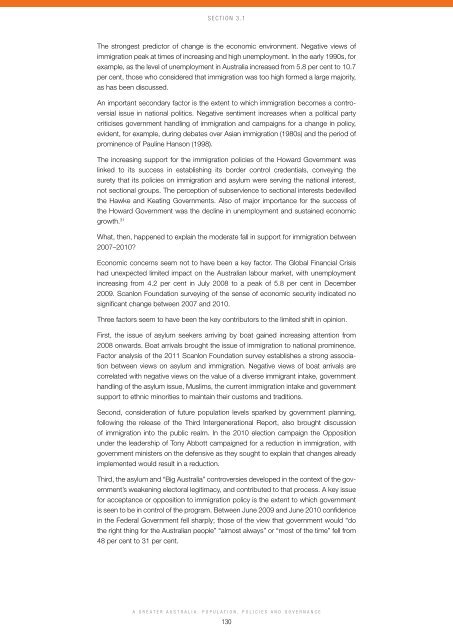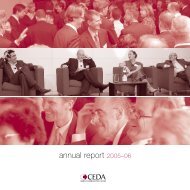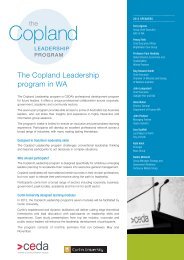A Greater Australia: Population, policies and governance - CEDA
A Greater Australia: Population, policies and governance - CEDA
A Greater Australia: Population, policies and governance - CEDA
- No tags were found...
You also want an ePaper? Increase the reach of your titles
YUMPU automatically turns print PDFs into web optimized ePapers that Google loves.
Section 3.1The strongest predictor of change is the economic environment. Negative views ofimmigration peak at times of increasing <strong>and</strong> high unemployment. In the early 1990s, forexample, as the level of unemployment in <strong>Australia</strong> increased from 5.8 per cent to 10.7per cent, those who considered that immigration was too high formed a large majority,as has been discussed.An important secondary factor is the extent to which immigration becomes a controversialissue in national politics. Negative sentiment increases when a political partycriticises government h<strong>and</strong>ling of immigration <strong>and</strong> campaigns for a change in policy,evident, for example, during debates over Asian immigration (1980s) <strong>and</strong> the period ofprominence of Pauline Hanson (1998).The increasing support for the immigration <strong>policies</strong> of the Howard Government waslinked to its success in establishing its border control credentials, conveying thesurety that its <strong>policies</strong> on immigration <strong>and</strong> asylum were serving the national interest,not sectional groups. The perception of subservience to sectional interests bedevilledthe Hawke <strong>and</strong> Keating Governments. Also of major importance for the success ofthe Howard Government was the decline in unemployment <strong>and</strong> sustained economicgrowth. 31What, then, happened to explain the moderate fall in support for immigration between2007–2010?Economic concerns seem not to have been a key factor. The Global Financial Crisishad unexpected limited impact on the <strong>Australia</strong>n labour market, with unemploymentincreasing from 4.2 per cent in July 2008 to a peak of 5.8 per cent in December2009. Scanlon Foundation surveying of the sense of economic security indicated nosignificant change between 2007 <strong>and</strong> 2010.Three factors seem to have been the key contributors to the limited shift in opinion.First, the issue of asylum seekers arriving by boat gained increasing attention from2008 onwards. Boat arrivals brought the issue of immigration to national prominence.Factor analysis of the 2011 Scanlon Foundation survey establishes a strong associationbetween views on asylum <strong>and</strong> immigration. Negative views of boat arrivals arecorrelated with negative views on the value of a diverse immigrant intake, governmenth<strong>and</strong>ling of the asylum issue, Muslims, the current immigration intake <strong>and</strong> governmentsupport to ethnic minorities to maintain their customs <strong>and</strong> traditions.Second, consideration of future population levels sparked by government planning,following the release of the Third Intergenerational Report, also brought discussionof immigration into the public realm. In the 2010 election campaign the Oppositionunder the leadership of Tony Abbott campaigned for a reduction in immigration, withgovernment ministers on the defensive as they sought to explain that changes alreadyimplemented would result in a reduction.Third, the asylum <strong>and</strong> “Big <strong>Australia</strong>” controversies developed in the context of the government’sweakening electoral legitimacy, <strong>and</strong> contributed to that process. A key issuefor acceptance or opposition to immigration policy is the extent to which governmentis seen to be in control of the program. Between June 2009 <strong>and</strong> June 2010 confidencein the Federal Government fell sharply; those of the view that government would “dothe right thing for the <strong>Australia</strong>n people” “almost always” or “most of the time” fell from48 per cent to 31 per cent.A <strong>Greater</strong> <strong>Australia</strong>: <strong>Population</strong>, Policies <strong>and</strong> Governance130





